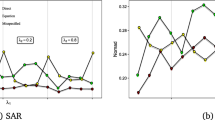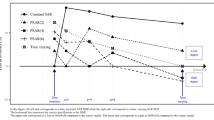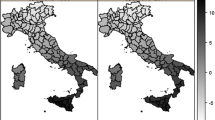Abstract
This paper proposes an extension of the Bayesian instrumental variables regression which allows spatial and temporal correlation among observations. For that, we introduce a double separable covariance matrix, adopting a Conditional Autoregressive structure for the spatial component, and a first-order autoregressive process for the temporal component. We also introduce a Bayesian multiple imputation to handle missing data considering uncertainty. The inference procedure is described joint with a step by step Monte Carlo Markov Chain algorithm for parameters estimation. We illustrate our methodology through a simulation study and a real application that investigates how broadband affects the Gross Domestic Product of municipalities in the state of Mato Grosso do Sul from 2010 to 2017.



Similar content being viewed by others
Availability of Data and Material
Available at https://github.com/marcuslavagnole.
References
Angrist, J. D., & Krueger, A. B. (1991). Does compulsory school attendance affect schooling and earnings? The Quarterly Journal of Economics, 106(4), 979–1014.
Barro, R. J., & Sala-i-Martin, X. (1995). Economic growth. MIT Press.
Besag, J., York, J., & Mollié, A. (1991). Bayesian image restoration with two applications in spatial statistics (with discussion). Annals of the Institute of Statistical Mathematics, 43, 1–59.
Bozza, S., & O’Hagan, A. (2003). A Bayesian approach for the estimation of the covariance structure of separable spatio-temporal stochastic processes. In M. Schader, W. Gaul, & M. Vichi (Eds.), Between data science and applied data analysis (pp. 165–172). Springer.
Carlin, B. P., & Banerjee, S. (2003). Hierarchical multivariate CAR models for spatially correlated survival data. Bayesian Statistics, 7, 45–65.
Celeux, G., Forbes, F., Robert, C. P., & Titterington, M. (2006). Deviance information criteria for missing data models. Bayesian Analysis, 1(4), 651–674.
Chen, H., Quandt, S. A., Grzywacz, J. G., & Arcury, T. A. (2013). A Bayesian multiple imputation method for handling longitudinal pesticide data with values below the limit of detection. Environmetrics, 24(2), 132–142.
Conley, T. G., Hansen, C. B., McCulloch, R. E., & Rossi, P. E. (2008). A semi-parametric Bayesian approach to the instrumental variable problem. Journal of Econometrics, 144(1), 276–305.
Cressie, N., & Wikle, C. K. (2011). Statistics for spatio-temporal data. Wiley.
Czernich, N., Falck, O., Kretschmer, T., & Woessmann, L. (2011). Broadband infrastructure and economic growth. The Economic Journal, 121(552), 505–532.
Forman, C., Goldfarb, A., & Greenstein, S. (2005). How did location affect adoption of the commercial internet? Global village vs. urban leadership. Journal of Urban Economics, 58(3), 389–420.
Fosdick, B. K., & Hoff, P. D. (2014). Separable factor analysis with applications to mortality data. Annals of Applied Statistics, 8(1), 120–147.
Gelfand, A. E., & Vounatsou, P. (2003). Proper multivariate conditional autoregressive models for spatial data analysis. Biostatistics, 4(1), 11–25.
Hahn, P. R., He, J., & Lopes, H. (2018). Bayesian factor model shrinkage for linear IV regression with many instruments. Journal of Business and Economic Statistics, 36(3), 278–287.
Hoogerheide, L., Kleibergen, F., & van Dijk, H. K. (2007). Natural conjugate priors for the instrumental variables regression model applied to the Angrist–Krueger data. Journal of Econometrics, 138(1), 63–103.
Jin, X., Banerjee, S., & Carlin, B. P. (2007). Order-free co-regionalized areal data models with application to multiple-disease mapping. Journal of the Royal Statistical Society, Series B, 69(5), 817–838.
Kleibergen, F., & Zivot, E. (2003). Bayesian and classical approaches to instrumental variable regression. Journal of Econometrics, 114(1), 29–72.
Knorr-Held, L. (2000). Bayesian modelling of inseparable space-time variation in disease risk. Statistics in Medicine, 19(17–18), 2555–2568.
Koutroumpis, P. (2009). The economic impact of broadband on growth: A simultaneous approach. Telecommunications Policy, 33(9), 471–485.
La Rose, R., Strover, S., Gregg, J. L., & Straubhaar, J. (2011). The impact of rural broadband development: Lessons from a natural field experiment. Government Information Quarterly, 28(1), 91–100.
Lancaster, T. (2004). An introduction to modern Bayesian. Wiley-Blackwell.
Little, R. J. A., & Rubin, D. B. (2002). Statistical analysis with missing data. Wiley.
Lopes, H. F., & Polson, N. G. (2014). Bayesian instrumental variables: Priors and likelihoods. Econometric Reviews, 39(1–4), 100–121.
Luo, S., Lawson, A. B., He, B., Elm, J. J., & Tilley, B. C. (2016). Bayesian multiple imputation for missing multivariate longitudinal data from a Parkinson’s disease clinical trial. Statistical Methods in Medical Research, 25(2), 821–837.
Mack, E. A. (2014). Businesses and the need for speed: The impact of broadband speed on business presence. Telematics and Informatics, 31(4), 617–627.
Manago, K. F., Hogue, T. S., Porter, A., & Hering, A. S. (2019). A Bayesian hierarchical model for multiple imputation of urban spatio-temporal groundwater levels. Statistics and Probability Letters, 144, 44–51.
Marfia, K. V. (1988). Multi-dimensional multivariate gaussian Markov random fields with application to image processing. Journal of Multivariate Analysis, 24(2), 265–284.
Moon, T. K. (1996). The expectation–maximization algorithm. IEEE Signal Processing Magazine, 13(6), 47–60.
Neri, Marcelo C., Vaz, Fabio M., de Souza, Pedro F. (2013.) “Efeitos Macroeconômicos do Programa Bolsa Família: Uma Análise Comparativa das Transferências Sociais.” In Programa Bolsa Família uma década de inclusão e cidadania, edited by Tereza Campello and Marcelo C. Neri, Brasília, DF, 193–206. Instituto de Pesquisa Econômica Aplicada.
Quick, H., Banerjee, S., & Carlin, B. P. (2013). Modeling temporal gradients in regionally aggregated California asthma hospitalization data. Annals of Applied Statistics, 7(1), 154–176.
R Core Team. (2020). R: A language and environment for statistical computing. R Foundation for Statistical Computing. https://www.R-project.org/.
Roller, L.-H., & Waverman, L. (2001). Telecommunications infrastructure and economic development: A simultaneous approach. American Economic Review, 91(4), 909–923.
Rossi, P. E., Allenby, G. M., & McCulloch, R. (2005). Bayesian statistics and marketing. Wiley.
Rougier, E., Combarnous, F., & Fauré, Y-A. (2018). The “local economy” effect of social transfers: An empirical assessment of the impact of the Bolsa Família program on local productive structure and economic growth. World Development, 103, 199–215.
Rubin, D. B. (1976). Inference and missing data. Biometrika, 63(3), 581–592.
Rubin, D. B. (1987). Multiple imputation for nonresponse in surveys. Wiley.
Schmidt, A. M., & Nobre, W. S. (2018). Conditional autoregressive (CAR) model. In N. Balakrishnan, T. Colton, B. Everitt, W. Piegorsch, F. Ruggeri, & J. Teugels (Eds.), Wiley StatsRef: Statistics reference online (pp. 1–11). Wiley.
Si, Y., & Reiter, J. P. (2013). Nonparametric Bayesian multiple imputation for incomplete categorical variables in large-scale assessment surveys. Journal of Educational and Behavioral Statistics, 38(5), 499–521.
Spiegelhalter, D. J., Best, N. G., Carlin, B. P., & van der Linde, A. (2002). Bayesian measures of model complexity and fit. Journal of the Royal Statistical Society, Series B, 64(4), 583–639.
Stein, M. L. (2005). Space-time covariance functions. Journal of the American Statistical Association, 100(469), 310–321.
Vidotto, D., Vermunt, J. K., & van Deun, K. (2018). Bayesian multilevel latent class models for the multiple imputation of nested categorical data. Journal of Educational and Behavioral Statistics, 43(5), 511–539.
Funding
No funding to declare.
Author information
Authors and Affiliations
Contributions
Marcus L. Nascimento provided the conception of the article, the implementation of the codes, and drafting the article; Kelly C. M. Gonçalves provided the conception and the revision of the article; Mario Jorge Mendonça supplied the data set.
Corresponding author
Ethics declarations
Conflict of interest
No conflicts of interest.
Ethical approval
No particular ethical approval was required for this study because it does not entail human participation or personal data.
Informed consent
No consent was required for this study because it does not entail human participation or personal data.
Additional information
Publisher's Note
Springer Nature remains neutral with regard to jurisdictional claims in published maps and institutional affiliations.
Appendices
Appendix A: Summary Statistics
See Table 4
Appendix B: Assessment of MCMC Convergence
Trace plots of MCMC draws for parameters \(\beta \), \(\beta ^{*}_{0}\), \(\beta ^{*}_{1}\), \(\beta ^{*}_{2}\) and \(\beta ^{*}_{3}\). The solid lines represent the true values and the dashed lines represent the 95% HPD intervals. The left panels display how quickly the parameters converge to the true values, and the right panels display the chain after considering the burn-in period and the thin
Trace plots of MCMC draws for parameters \(\delta _{0}\), \(\delta _{1}\), \(\phi \) and \(\rho \). The solid lines represent the true values and the dashed lines represent the 95% HPD intervals. The left panels display how quickly the parameters converge to the true values, and the right panels display the chain after considering the burn-in period and the thin
Rights and permissions
About this article
Cite this article
Nascimento, M.L., Gonçalves, K.C.M. & Mendonça, M.J. Spatio-Temporal Instrumental Variables Regression with Missing Data: A Bayesian Approach. Comput Econ 62, 29–47 (2023). https://doi.org/10.1007/s10614-022-10269-z
Accepted:
Published:
Issue Date:
DOI: https://doi.org/10.1007/s10614-022-10269-z






